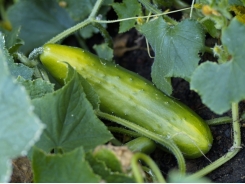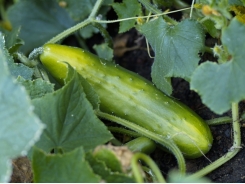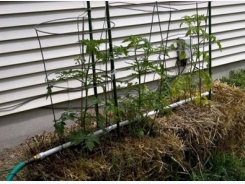Expert Tips for Tomato Ring Culture Supergrowth

The ring culture of tomatoes or ‘tomato ring culture’ is now widely practised. It is a method which provides controlled conditions of nourishment and water supply. It was first practised at the Tilgate Horticultural Research Station in Sussex.
Because of indifferent crops then being produced, it was decided to grow greenhouse tomatoes in some large bottomless earthen ware rings or containers. These rings were filled with compost and planted in the usual way. By chance some of the rings had been placed on a tiled floor such as found in old conservatories and growing rooms, and some or part of the floor which had been covered with ashes from a coal fired boiler.
It was found that the plants standing over the ash grew much more freely and cropped much more heavily. Since all plants were grown in the same compost and had the same attention no answer could be at first found for their greatly differing results.
When the rings were moved it was discovered that it was the plants which had grown over the ash base that had fruited so heavily. They had made a strong secondary root system in the ash layer which had remained damp allowing the roots to spread out widely. The plants standing over the tiles had their roots restricted to the rings.
Rings of widely varied materials have been used, and apart from weathered ashes, many other materials have been employed on which to stand the rings. These layers are known as aggregates, and among those now used are small grade clinkers, sand, crushed ballast and peat. Gravel can be used but is not so moisture retentive as the other materials. The same applies to stone chippings and very coarse clinkers. The depth of the aggregate is not important except that it should not be less than 10cm although there does not seem any advantage in going beyond 15cm.
Although not essential, where there has previously been trouble from disease or eelworm, an effective way of isolating the aggregate layer from the greenhouse soil is to first provide a layer of polythene, or even concrete for a more permanent separation. In either case some provision must be made for the escape of surplus water, although the aggregate must be kept constantly moist so that the lower zone of roots never dries out. Any possibility of water-logging resulting in unhealthy root action must be avoided.
Where there is sufficient height, tomatoes can be grown in rings on greenhouse benches, for provided shade is given, the plants can be trained to the roof There is no problem in growing tomatoes in rings in the open ground, although it is best to select a south facing site. If the aggregate layer is raised a little above the surrounding soil it prevents compost being washed into or rain beaten, over the aggregate. Alternatively boards can be placed round the aggregate to keep it intact.
The John Innes Compost No. 3 was used in the initial trials and properly made, it is not so liable to dry out as ‘ordinary’ composts which are often too light, depending on the type of loam used. This perhaps is not so important once the secondary roots in the aggregate are working well. When they are not and the feeding roots in. the rings dry out, the foliage may wilt and some of the flowers fall before they set.
Here perhaps is the place to mention the size of the rings. It is now possible to buy a number of types of bituminised cardboard and similar material. A good size is 20cm deep with a top diameter of 23cm. Having made a 5 to 8cm layer of compost firm on the bottom of the ring (placed on the aggregate) the tomato plant should be taken from its pot and placed firmly in the ring pressing the soil closely around the ball of roots without damaging them. Bring the soil to within 4cms of the top of the ring this space being left for watering and then for feeding. Then give a good watering so the roots settle in their new compost. After about ten days, apply water close to the plant stem, (this is ball watering) and make the aggregate wet and keep it so.
After a month or so roots will be penetrating the aggregate and ball watering should cease, all moisture then being drawn through the secondary root system. By this time the nutrients in the rings will be almost exhausted and feeding into the rings at seven day intervals should be commenced.
Do not water into the rings after feeding until it is evident that the compost is becoming dry. Lack of free moisture in the container causes the foliage to droop a little and lose its fresh lively colour. It is always best to feed in solution, since with the comparatively little watering into the rings there is less opportunity for the solid feed to be carried to the fibrous roots.
The fertiliser first used on tomatoes grown in the tomato ring culture method, ie in rings, was known as 667 from the analysis of 6% each of nitrogen and phosphoric acid, and 7% potash, which provides the necessary magnesium for good colour. Once the first truss has set, liquid organic fertiliser should be given at seven day intervals. It is now possible to obtain a number of really good non-forcing organic fertilisers with a similar analysis.
You must bear in mind that plants in rings do require more feeding than those in the border. Otherwise they become half-starved, growth is indifferent, and the quality and quantity of the fruit poor.
The removal of side shoots and general attention needed by tomatoes grow in the tomato ring culture method is the same as that required by plants grown under the usual method.
Related news
Tools

Phối trộn thức ăn chăn nuôi

Pha dung dịch thủy canh

Định mức cho tôm ăn

Phối trộn phân bón NPK

Xác định tỷ lệ tôm sống

Chuyển đổi đơn vị phân bón

Xác định công suất sục khí

Chuyển đổi đơn vị tôm

Tính diện tích nhà kính

Tính thể tích ao




 Expert Tips for Growing Tomatos Outdoors
Expert Tips for Growing Tomatos Outdoors  Expert Tips for Growing Garden Tomatoes – Straw…
Expert Tips for Growing Garden Tomatoes – Straw…